Impact of Courtyard Microclimate on Building Thermal Performance Under Hot Weather Conditions: A Review
Abstract
1. Introduction
2. Materials and Methods
- Scope: Building thermal performance and/or energy demand.
- Subject: Courtyard buildings.
- Scenario: Hot climates, summer conditions, or extreme heat events.
- Publication year range: 2015–2025
- Language: English
- Document types in WoS and Scopus: Articles, review articles, and book chapters
- Research areas: Differences between WoS and Scopus are detailed in Table 1.
3. Results
3.1. Quantitative Analysis
3.2. Qualitative Analysis
3.2.1. Keyword Co-Occurrence Analysis
3.2.2. Cluster Analysis
3.2.3. Timeline Analysis
- Since 2015, the central role of “thermal comfort” has established building thermal comfort as the most critical driving factor in courtyard research.
- Between 2017 and 2021, the increasing weight of “buildings” and “energy consumption” reflected a shift in research focus from courtyard microclimate characteristics to their impact on overall building thermal performance, with strong attention to energy consumption. The concentrated emergence of “CFD simulation”, “microclimate”, and “optimization” signaled the widespread application of numerical simulation techniques in the analysis of courtyard microclimates and thermal performance.
- Since 2022, research trends have focused on extreme climate adaptation. The emergence of “climate adaptive”, “climate resilient design”, “courtyard microclimate”, and “architectural design” indicates that courtyard microclimates are increasingly regarded as key design strategies for enhancing building climate adaptability and resilience. “Indoor thermal comfort”, “multi-zone airflow modeling”, and “building performance simulation” reflect a methodological shift toward refined indoor thermal performance simulation to address the growing risk of indoor overheating.
3.2.4. Keyword Bursts
- 2015–2017: Passive cooling and vernacular architecture marked the exploration of passive technologies in traditional architecture within this field.
- 2017–2018: Natural ventilation and strategy indicated a growing focus on the complex wind environments of courtyards and surrounding buildings, as research shifted from observational phenomena to strategic development.
- 2019–2021: Numerical simulation and optimization reflected a shift toward quantitative analysis and performance optimization, with increasing reliance on advanced computational simulation techniques.
- Post-2021: Climate and environment highlighted the strengthening association between courtyard design research and broader climate and environmental issues.
4. Discussion
4.1. Key Mechanisms of Courtyard Effects on Building Thermal Performance
4.1.1. Solar Gain Control
4.1.2. Airflow Regulation
4.1.3. Evaporative Cooling
4.1.4. Thermal Buffering
4.2. Assessment Methods for Courtyard Building Thermal Performance
4.3. Courtyard Design Strategies for Extreme Heat Mitigation
4.3.1. Geometric Configuration Strategies
4.3.2. Material Performance Strategies
4.3.3. Landscape Design Strategies
5. Conclusions
- Thermal performance regulation mechanisms: Courtyard buildings improve the microclimate through four mechanisms—solar gain control, airflow organization, evaporative cooling, and thermal buffering. These mechanisms do not function as simple linear superpositions but rather interact to form a dynamic balance that collectively determines the overall thermal performance of courtyards.
- Research methods and scale selection: The choice of methods for quantifying such impacts should depend on specific research objectives. When exploring fundamental mechanisms, in-depth analysis using a single method is often more effective than complex couplings, whereas for practical applications, comprehensive evaluation and uncertainty analysis are more critical. Different analytical scales reveal significantly different insights, requiring researchers to strike a balance between methodological precision and practical feasibility.
- Integrated design strategies: Effective courtyard design must reconcile internal conflicts among mechanisms, adapt to the specific requirements of different climatic conditions, and employ multi-strategy coordination to avoid overall performance degradation caused by over-optimization of a single strategy. This requires designers to move beyond traditional segmented optimization and adopt an integrated design approach.
Author Contributions
Funding
Data Availability Statement
Conflicts of Interest
Appendix A
| 4.1. Key Mechanisms of Courtyard Effects on Building Thermal Performance |
| Xu et al., 2018 [20]; Salameh 2024 [36]; Domínguez-Torres and Domínguez-Delgado 2024 [37]; M’Saouri El Bat et al., 2023 [38]; Zhang et al., 2024 [39]; Sun et al., 2023 [40]; Diz-Mellado et al., 2023a [41]; He et al., 2022 [42]; Albaik and Muhsen 2025 [43]; Toe and Kubota 2015 [44]; Forouzandeh 2022 [45]; Darvish et al., 2021 [46]; Chi et al., 2022 [47]; Zhou et al., 2024 [48]; He and Osmond 2024 [49]; Bian et al., 2022 [50]; Wu et al., 2024 [51]; Yao et al., 2020 [52]; Palomo Amores et al., 2025 [53]; Freewan and Khatatbeh 2023 [54]; Gomaa et al., 2024 [55]; Sun et al., 2024 [56]; Diz-Mellado et al., 2023b [57]; Chidiadi and Taki 2025 [58]; Zamani et al., 2019 [59]; Lizana et al., 2022 [60]; Gamage et al., 2017 [61] |
| 4.2. Assessment Methods for Courtyard Building Thermal Performance |
| Zamani et al., 2018 [17]; Tabadkani et al., 2022 [23]; Salameh 2024 [36]; Toe and Kubota 2015 [44]; Darvish et al., 2021 [46]; Palomo Amores et al., 2025 [53]; Sun et al., 2024 [56]; Lizana et al., 2022 [60]; ALshabanat and Omer 2023 [62]; Kubota et al., 2017 [63]; Yan et al., 2024 [64]; Nugroho et al., 2020 [65]; Chohan et al., 2024 [66]; Abdallah 2022 [67]; López-Cabeza et al., 2022 [68]; Zhao et al., 2025 [69]; Salameh and Touqan 2024 [70] |
| 4.3. Courtyard Design Strategies for Extreme Heat Mitigation |
| Hao et al., 2019 [18]; Domínguez-Torres and Domínguez-Delgado 2024 [37]; M’Saouri El Bat et al., 2023 [38]; Diz-Mellado et al., 2023a [41]; He et al., 2022 [42]; Forouzandeh 2022 [45]; Darvish et al., 2021 [46]; Gomaa et al., 2024 [55]; Sun et al., 2024 [56]; Diz-Mellado et al., 2023b [57]; Chidiadi and Taki 2025 [58]; Zamani et al., 2019 [59]; Kubota et al., 2017 [63]; Almahmoud et al., 2024 [71]; Erdemir Kocagil and Koçlar Oral 2016 [72]; Razavian et al., 2023 [73]; Sun et al., 2021 [74]; Li et al., 2019 [75] |
References
- UNEP. Facts About the Climate Emergency | UNEP—UN Environment Programme. Available online: https://www.unep.org//facts-about-climate-emergency (accessed on 14 June 2025).
- Mukherjee, M.; Fransen, S. Exploring Migration Decision-Making and Agricultural Adaptation in the Context of Climate Change: A Systematic Review. World Dev. 2024, 179, 106600. [Google Scholar] [CrossRef]
- Jiang, L.; Zhang, J.; Liu, Q.; Meng, X.; Shi, L.; Zhang, D.; Xing, M. Spatiotemporal Variations of the Global Compound Heat Wave and the Drivers of Its Spatial Heterogeneity. J. Clean. Prod. 2023, 408, 137201. [Google Scholar] [CrossRef]
- Ma, F.; Yuan, X.; Jiao, Y.; Ji, P. Unprecedented Europe Heat in June–July 2019: Risk in the Historical and Future Context. Geophys. Res. Lett. 2020, 47, e2020GL087809. [Google Scholar] [CrossRef]
- Malinina, E.; Gillett, N.P. The 2021 Heatwave Was Less Rare in Western Canada than Previously Thought. Weather Clim. Extrem. 2024, 43, 100642. [Google Scholar] [CrossRef]
- Liu, C.; Lu, B.; Liu, J.; Yang, F.; Jiang, H.; Ma, Z.; Liu, Q.; Li, J.; Liu, W. The Compound Heatwave and Drought Event in the Summer of 2022 and the Impacts on the Power System in Southwest China. Energies 2025, 18, 2424. [Google Scholar] [CrossRef]
- World Meteorological Organization (WMO). State of the Global Climate. 2023. Available online: https://library.wmo.int/records/item/68835-state-of-the-global-climate-2023 (accessed on 26 August 2025).
- Li, X.; Zhou, Y.; Yu, S.; Jia, G.; Li, H.; Li, W. Urban Heat Island Impacts on Building Energy Consumption: A Review of Approaches and Findings. Energy 2019, 174, 407–419. [Google Scholar] [CrossRef]
- Salvati, A.; Coch Roura, H.; Cecere, C. Assessing the Urban Heat Island and Its Energy Impact on Residential Buildings in Mediterranean Climate: Barcelona Case Study. Energy Build. 2017, 146, 38–54. [Google Scholar] [CrossRef]
- Roxon, J.; Ulm, F.-J.; Pellenq, R.J.-M. Urban Heat Island Impact on State Residential Energy Cost and CO2 Emissions in the United States. Urban Clim. 2020, 31, 100546. [Google Scholar] [CrossRef]
- He, B.-J. Towards the next Generation of Green Building for Urban Heat Island Mitigation: Zero UHI Impact Building. Sustain. Cities Soc. 2019, 50, 101647. [Google Scholar] [CrossRef]
- Azimi Fereidani, N.; Rodrigues, E.; Gaspar, A.R. A Review of the Energy Implications of Passive Building Design and Active Measures under Climate Change in the Middle East. J. Clean. Prod. 2021, 305, 127152. [Google Scholar] [CrossRef]
- Hu, M.; Zhang, K.; Nguyen, Q.; Tasdizen, T. The Effects of Passive Design on Indoor Thermal Comfort and Energy Savings for Residential Buildings in Hot Climates: A Systematic Review. Urban Clim. 2023, 49, 101466. [Google Scholar] [CrossRef]
- Prabhakar, M.; Saffari, M.; De Gracia, A.; Cabeza, L.F. Improving the Energy Efficiency of Passive PCM System Using Controlled Natural Ventilation. Energy Build. 2020, 228, 110483. [Google Scholar] [CrossRef]
- Elnabawi, M.H.; Saber, E.; Bande, L. Passive Building Energy Saving: Building Envelope Retrofitting Measures to Reduce Cooling Requirements for a Residential Building in an Arid Climate. Sustainability 2024, 16, 626. [Google Scholar] [CrossRef]
- Leng, H.; Chen, X.; Ma, Y.; Wong, N.H.; Ming, T. Urban Morphology and Building Heating Energy Consumption: Evidence from Harbin, a Severe Cold Region City. Energy Build. 2020, 224, 110143. [Google Scholar] [CrossRef]
- Zamani, Z.; Heidari, S.; Hanachi, P. Reviewing the Thermal and Microclimatic Function of Courtyards. Renew. Sustain. Energy Rev. 2018, 93, 580–595. [Google Scholar] [CrossRef]
- Hao, S.; Yu, C.; Xu, Y.; Song, Y. The Effects of Courtyards on the Thermal Performance of a Vernacular House in a Hot-Summer and Cold-Winter Climate. Energies 2019, 12, 1042. [Google Scholar] [CrossRef]
- Abass, F.; Ismail, L.H.; Solla, M. A Review of Courtyard House: History Evolution Forms, and Functions. ARPN J. Eng. Appl. Sci. 2016, 11, 2557–2563. [Google Scholar]
- Xu, X.; Luo, F.; Wang, W.; Hong, T.; Fu, X. Performance-Based Evaluation of Courtyard Design in China’s Cold-Winter Hot-Summer Climate Regions. Sustainability 2018, 10, 3950. [Google Scholar] [CrossRef]
- Wang, Z.; Ji, Y.; Su, X. Influence of Outdoor and Indoor Microclimate on Human Thermal Adaptation in Winter in the Severe Cold Area, China. Build. Environ. 2018, 133, 91–102. [Google Scholar] [CrossRef]
- Han, J.; Li, X.; Li, B.; Yang, W.; Yin, W.; Peng, Y.; Feng, T. Research on the Influence of Courtyard Space Layout on Building Microclimate and Its Optimal Design. Energy Build. 2023, 289, 113035. [Google Scholar] [CrossRef]
- Tabadkani, A.; Aghasizadeh, S.; Banihashemi, S.; Hajirasouli, A. Courtyard Design Impact on Indoor Thermal Comfort and Utility Costs for Residential Households: Comparative Analysis and Deep-Learning Predictive Model. Front. Archit. Res. 2022, 11, 963–980. [Google Scholar] [CrossRef]
- Rodríguez-Algeciras, J.; Tablada, A.; Chaos-Yeras, M.; De La Paz, G.; Matzarakis, A. Influence of Aspect Ratio and Orientation on Large Courtyard Thermal Conditions in the Historical Centre of Camagüey-Cuba. Renew. Energy 2018, 125, 840–856. [Google Scholar] [CrossRef]
- Martinelli, L.; Matzarakis, A. Influence of Height/Width Proportions on the Thermal Comfort of Courtyard Typology for Italian Climate Zones. Sustain. Cities Soc. 2017, 29, 97–106. [Google Scholar] [CrossRef]
- Sözen, İ.; Koçlar Oral, G. Outdoor Thermal Comfort in Urban Canyon and Courtyard in Hot Arid Climate: A Parametric Study Based on the Vernacular Settlement of Mardin. Sustain. Cities Soc. 2019, 48, 101398. [Google Scholar] [CrossRef]
- Taleghani, M.; Tenpierik, M.; Van Den Dobbelsteen, A.; Sailor, D.J. Heat Mitigation Strategies in Winter and Summer: Field Measurements in Temperate Climates. Build. Environ. 2014, 81, 309–319. [Google Scholar] [CrossRef]
- Marchi, L.; Gaspari, J.; Fabbri, K. Outdoor Microclimate in Courtyard Buildings: Impact of Building Perimeter Configuration and Tree Density. Buildings 2023, 13, 2687. [Google Scholar] [CrossRef]
- Shashua-Bar, L.; Pearlmutter, D.; Erell, E. The Cooling Efficiency of Urban Landscape Strategies in a Hot Dry Climate. Landsc. Urban Plan. 2009, 92, 179–186. [Google Scholar] [CrossRef]
- Zhu, J.; Feng, J.; Lu, J.; Chen, Y.; Li, W.; Lian, P.; Zhao, X. A Review of the Influence of Courtyard Geometry and Orientation on Microclimate. Build. Environ. 2023, 236, 110269. [Google Scholar] [CrossRef]
- Liu, S.; Sailor, D.J.; Fang, X.; Wu, R. The Role of Outdoor Courtyard Design Variables in Microclimate Performance: A Review. Arch. Sci. Rev. 2024, 68, 224–239. [Google Scholar] [CrossRef]
- Pranckutė, R. Web of Science (WoS) and Scopus: The Titans of Bibliographic Information in Today’s Academic World. Publications 2021, 9, 12. [Google Scholar] [CrossRef]
- Aria, M.; Cuccurullo, C. Bibliometrix: An R-Tool for Comprehensive Science Mapping Analysis. J. Informetr. 2017, 11, 959–975. [Google Scholar] [CrossRef]
- Chen, C.; Song, M. Visualizing a Field of Research: A Methodology of Systematic Scientometric Reviews. PLoS ONE 2019, 14, e0223994. [Google Scholar] [CrossRef] [PubMed]
- Peng, Y.; Gaspari, J.; Marchi, L. Exploring Residential Energy Behaviour of the Younger Generation for Sustainable Living: A Systematic Review. Energies 2024, 17, 3043. [Google Scholar] [CrossRef]
- Salameh, M. Modifying School Courtyard Design to Optimize Thermal Conditions and Energy Consumption in a Hot Arid Climate. J. Archit. Eng. 2024, 30, 04024033. [Google Scholar] [CrossRef]
- Domínguez-Torres, C.-A.; Domínguez-Delgado, A. Impact of Radiative Cooling on the Energy Performance of Courtyards in Mediterranean Climate. Build. Simul. 2024, 17, 1491–1513. [Google Scholar] [CrossRef]
- M’Saouri El Bat, A.; Romani, Z.; Bozonnet, E.; Draoui, A.; Allard, F. Optimizing Urban Courtyard Form through the Coupling of Outdoor Zonal Approach and Building Energy Modeling. Energy 2023, 264, 126176. [Google Scholar] [CrossRef]
- Zhang, M.; Fang, Z.; Liu, Q.; Zhang, F. Simulation and Analysis of Factors Influencing Climate Adaptability and Strategic Application in Traditional Courtyard Residences in Hot-Summer and Cold-Winter Regions: A Case Study of Xuzhou, China. Sustainability 2024, 16, 8676. [Google Scholar] [CrossRef]
- Sun, Q.; Luo, Z.; Bai, L. The Impact of Internal Courtyard Configuration on Thermal Performance of Long Strip Houses. Buildings 2023, 13, 371. [Google Scholar] [CrossRef]
- Diz-Mellado, E.; Ruiz-Pardo, Á.; Rivera-Gómez, C.; Sanchez De La Flor, F.J.; Galán-Marín, C. Unravelling the Impact of Courtyard Geometry on Cooling Energy Consumption in Buildings. Build. Environ. 2023, 237, 110349. [Google Scholar] [CrossRef]
- He, C.; Tian, W.; Shao, Z. Impacts of Courtyard Envelope Design on Energy Performance in the Hot Summer–Cold Winter Region of China. Buildings 2022, 12, 173. [Google Scholar] [CrossRef]
- Albaik, M.; Muhsen, R. Optimizing Building Performance: A Grasshopper Modeling Case Study of the King Hussein Mosque. IEEE Access 2025, 13, 47244–47259. [Google Scholar] [CrossRef]
- Toe, D.H.C.; Kubota, T. Comparative Assessment of Vernacular Passive Cooling Techniques for Improving Indoor Thermal Comfort of Modern Terraced Houses in Hot–Humid Climate of Malaysia. Sol. Energy 2015, 114, 229–258. [Google Scholar] [CrossRef]
- Forouzandeh, A. Comparative Analysis of Sol-Air Temperature in Typical Open and Semi-Closed Courtyard Spaces. Build. Simul. 2022, 15, 957–973. [Google Scholar] [CrossRef]
- Darvish, A.; Eghbali, G.; Eghbali, S.R. Tree-Configuration and Species Effects on the Indoor and Outdoor Thermal Condition and Energy Performance of Courtyard Buildings. Urban Clim. 2021, 37, 100861. [Google Scholar] [CrossRef]
- Chi, F.; Xu, Y.; Pan, J. Impact of Shading Systems with Various Type-Number Configuration Combinations on Energy Consumption in Traditional Dwelling (China). Energy 2022, 255, 124520. [Google Scholar] [CrossRef]
- Zhou, Z.; Xu, Y.; Ouyang, C.; Gui, M.; Jiang, W.; Zhou, C.; Ma, K.; Zhang, J.; Huang, J. Climate Adaptability Research of Vernacular Dwellings in Jiangxi Based on Numerical Simulation—An Example from Nanfeng County. Buildings 2024, 14, 2211. [Google Scholar] [CrossRef]
- He, C.; Osmond, P. Performance of Traditional Chinese Courtyard Buildings from a Sustainability Perspective and Implications for Contemporary Green Building Design. J. Chin. Archit. Urban. 2024, 6, 3187. [Google Scholar] [CrossRef]
- Bian, M.; Huang, Z.; Chen, Q.; Liu, G.; Zhang, Y.; Ding, S. Optimization of Plane and Space of New Dwellings in Southern Anhui Province Based on Indoor Thermal Environment. Sustainability 2022, 14, 5694. [Google Scholar] [CrossRef]
- Wu, S.; Zhang, L.; Han, Z.; Hu, C.; An, D. Research on Microclimate Optimization of Traditional Residential Buildings in Central Anhui Based on Humid and Hot Climate Characteristics and Regional Architectural Features. Buildings 2024, 14, 2323. [Google Scholar] [CrossRef]
- Yao, X.; Dewancker, B.J.; Guo, Y.; Han, S.; Xu, J. Study on Passive Ventilation and Cooling Strategies for Cold Lanes and Courtyard Houses—A Case Study of Rural Traditional Village in Shaanxi, China. Sustainability 2020, 12, 8687. [Google Scholar] [CrossRef]
- Palomo Amores, T.; Ruda Sarria, F.; Medina, D.C.; Valera, T.C.; Sánchez Ramos, J.; Álvarez Domínguez, S. Experimental Validation of the Potential of Cross-Ventilation Strategy as a Natural Cooling Technique Integrated in a Real Historic Building. Appl. Sci. 2025, 15, 2174. [Google Scholar] [CrossRef]
- Freewan, A.; Khatatbeh, A. The Impact of Modifying Courtyard Wall Geometries on Thermal Performance and Natural Ventilation of Two Storey Building. 2023. Available online: https://d1wqtxts1xzle7.cloudfront.net/114492974/THE_IMPACT_OF_MODIFYING_COURTYARD_WALL_GEOMETRIES_ON_THERMAL_PERFORMANCE_AND_NATURAL_VENTILATION_OF_TWO_STOREY_BUILDING-libre.pdf?1715605428=&response-content-disposition=inline%3B+filename%3DTHE_IMPACT_OF_MODIFYING_COURTYARD_WALL_G.pdf&Expires=1760410704&Signature=Ti~tonQX8eHLq5jLjrdEyoiR7tZkN8LK3u~KPf09E3pIyjQ6E5hGguST59qmf6eMixzkOPbfujFd7hKpiQNuqiOwS~zBzrb4M-4YCjeR645jjpMRAh0foL2bls33ILGakIaaxgmwVXMbgJiH-ZwziF19D-85-bIZOL9pz5Bng7yKa7cUZ6QxbbliEI3-zfIvHoJGSfxkL~WBcJMPXCQxSIS8mVsaL5xI5PMB-MdoVnSbZ6I29knvqwPSAekOZ5eep8BcOJlWu3Ugjxt7GiYzqBZPTyssfDAkJUavojxks4t5ZzaulP4al1-ljghghrtQDSqHBgoF7xYgwaOr~cRuJQ__&Key-Pair-Id=APKAJLOHF5GGSLRBV4ZA (accessed on 26 June 2025).
- Gomaa, M.M.; Othman, E.; Mohamed, A.F.; Ragab, A. Quantifying the Impacts of Courtyard Vegetation on Thermal and Energy Performance of University Buildings in Hot Arid Regions. Urban Sci. 2024, 8, 136. [Google Scholar] [CrossRef]
- Sun, H.; Zhong, H.; Dik, A.; Ding, K.; Jimenez-Bescos, C.; Calautit, J.K. Numerical Investigation of Evaporative Cooling Strategies on the Aero-Thermal Performance of Courtyard Buildings in Hot-Dry Climates. Build. Environ. 2024, 258, 111588. [Google Scholar] [CrossRef]
- Diz-Mellado, E.; López-Cabeza, V.P.; Rivera-Gómez, C.; Galán-Marín, C. Performance Evaluation and Users’ Perception of Courtyards Role in Indoor Areas of Mediterranean Social Housing. J. Environ. Manag. 2023, 345, 118788. [Google Scholar] [CrossRef]
- Chidiadi, E.; Taki, A. Examining the Impact of Multilevel Courtyards in Hot-Dry and Humid Climates. Energies 2025, 18, 2425. [Google Scholar] [CrossRef]
- Zamani, Z.; Heidari, S.; Azmoodeh, M.; Taleghani, M. Energy Performance and Summer Thermal Comfort of Traditional Courtyard Buildings in a Desert Climate. Environ. Prog. Sustain. Energy 2019, 38, e13256. [Google Scholar] [CrossRef]
- Lizana, J.; López-Cabeza, V.P.; Renaldi, R.; Diz-Mellado, E.; Rivera-Gómez, C.; Galán-Marín, C. Integrating Courtyard Microclimate in Building Performance to Mitigate Extreme Urban Heat Impacts. Sustain. Cities Soc. 2022, 78, 103590. [Google Scholar] [CrossRef]
- Gamage, W.; Lau, S.; Qin, H.; Gou, Z. Effectiveness of Air-Well Type Courtyards on Moderating Thermal Environments in Tropical Chinese Shophouse. Archit. Sci. Rev. 2017, 60, 493–506. [Google Scholar] [CrossRef]
- ALshabanat, A.; Omer, S. The Potential of Green Engineering Solutions for Energy Conservation in Residential Buildings towards Sustainability: A Case Study of Saudi Arabia. Architecture 2023, 3, 713–738. [Google Scholar] [CrossRef]
- Kubota, T.; Zakaria, M.A.; Abe, S.; Toe, D.H.C. Thermal Functions of Internal Courtyards in Traditional Chinese Shophouses in the Hot-Humid Climate of Malaysia. Build. Environ. 2017, 112, 115–131. [Google Scholar] [CrossRef]
- Yan, S.; He, J.; Peng, S.; Fang, Z.; Zhou, X. Assessing the Thermal Risks for Residents and Visitors in Traditional Street-Facing Dwellings with Eaves Gallery during an Extreme Heatwave Event. Build. Environ. 2024, 251, 111233. [Google Scholar] [CrossRef]
- Nugroho, A.M.; Citraningrum, A.; Iyati, W.; Ahmad, M.H. Courtyard as Tropical Hot Humid Passive Design Strategy: Case Study of Indonesian Contemporary Houses in Surabaya Indonesia. J. Des. Built Environ. 2020, 20, 1–12. [Google Scholar] [CrossRef]
- Chohan, A.H.; Awad, J.; Ismail, M.A.; Arar, M.S. Integrating Technology and Heritage Design for Climate Resilient Courtyard House in Arid Region. Civ. Eng. J. 2024, 10, 928–952. [Google Scholar] [CrossRef]
- Abdallah, A.S.H. Passive Design Strategies to Improve Student Thermal Comfort in Assiut University: A Field Study in the Faculty of Physical Education in Hot Season. Sustain. Cities Soc. 2022, 86, 104110. [Google Scholar] [CrossRef]
- López-Cabeza, V.P.; Lizana, J.; Diz-Mellado, E.; Rivera-Gómez, C.; Galán-Marín, C. Outdoor Microclimate Influence on Building Performance: Simulation Tools, Challenges, and Opportunities. In New Technologies in Building and Construction: Towards Sustainable Development; Bienvenido-Huertas, D., Moyano-Campos, J., Eds.; Springer Nature: Singapore, 2022; pp. 103–121. ISBN 978-981-19-1894-0. [Google Scholar]
- Zhao, M.; Künzel, H.M.; Mehra, S.-R. Application of Multi-Zone Airflow Modeling in the Investigation of Climate-Regulating Effects of Courtyards. Build. Environ. 2025, 280, 113130. [Google Scholar] [CrossRef]
- Salameh, M.; Touqan, B. Optimizing Educational Environments: Microclimate Analysis and Energy Efficiency through Courtyard Orientation in UAE Schools. Front. Built Environ. 2024, 10, 1448743. [Google Scholar] [CrossRef]
- Almahmoud, E.; Elgheriani, L.; Almhafdy, A. Cooling Load Reduction in Courtyard Houses: Examining the Role of Courtyard Configuration in a Hot, Arid Climate. JES J. Eng. Sci. 2024, 52, 728–738. [Google Scholar] [CrossRef]
- Erdemir Kocagil, İ.; Koçlar Oral, G. The Effect of Solar Heat Gain on Climate Responsive Courtyard Buildings. AZ ITU J. Fac. Archit. 2016, 13, 39–46. [Google Scholar] [CrossRef]
- Razavian, F.S.; Alemi, B.; Zarchi, S.K. Studying and Proposing an Energy-Efficient Residential Design for Kashan with a Hot and Dry Climate. J. Sol. Energy Res. 2023, 8, 1559–1573. [Google Scholar]
- Sun, H.; Jimenez-Bescos, C.; Mohammadi, M.; Zhong, F.; Calautit, J.K. Numerical Investigation of the Influence of Vegetation on the Aero-Thermal Performance of Buildings with Courtyards in Hot Climates. Energies 2021, 14, 5388. [Google Scholar] [CrossRef]
- Li, Z.; Chow, D.H.C.; Yao, J.; Zheng, X.; Zhao, W. The Effectiveness of Adding Horizontal Greening and Vertical Greening to Courtyard Areas of Existing Buildings in the Hot Summer Cold Winter Region of China: A Case Study for Ningbo. Energy Build. 2019, 196, 227–239. [Google Scholar] [CrossRef]
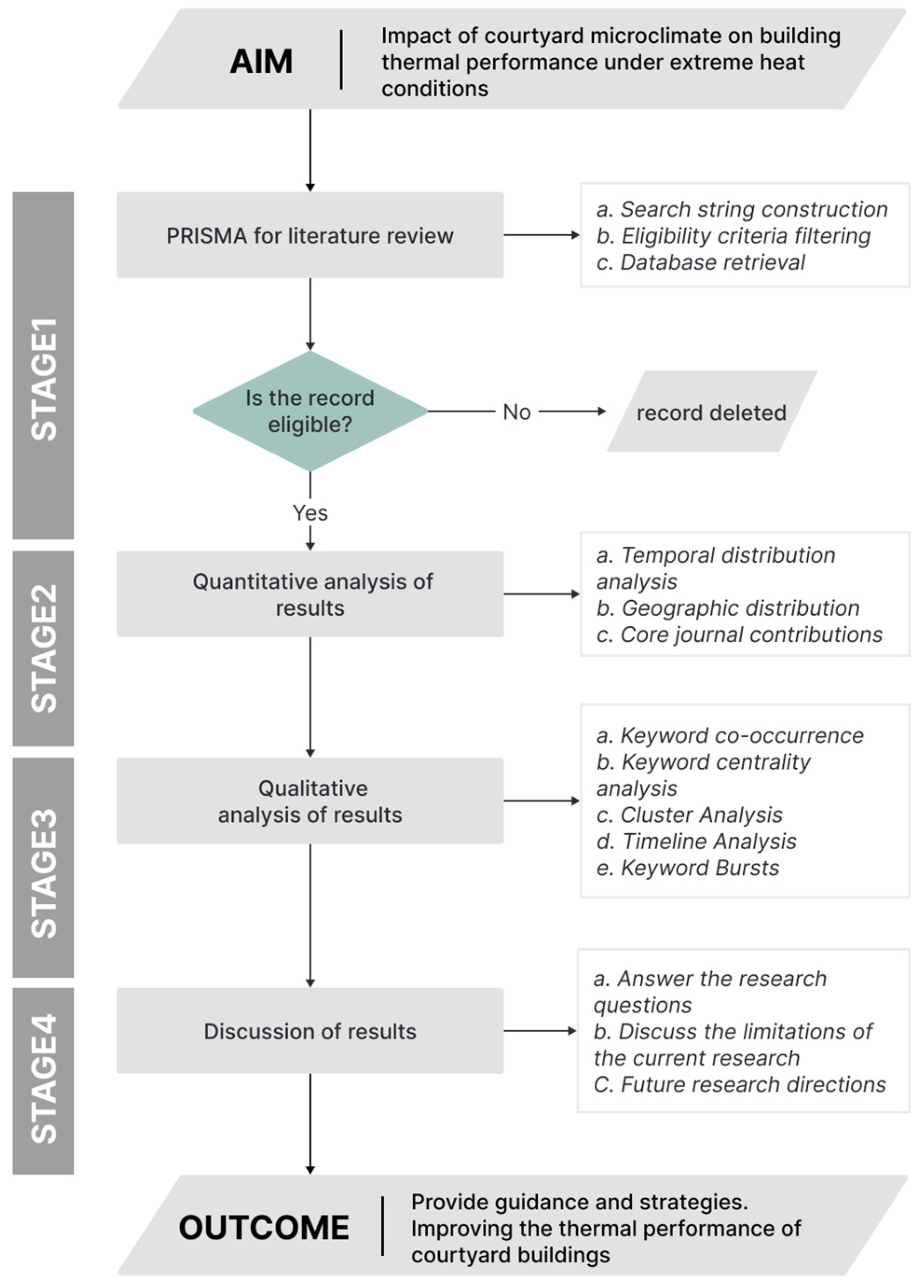
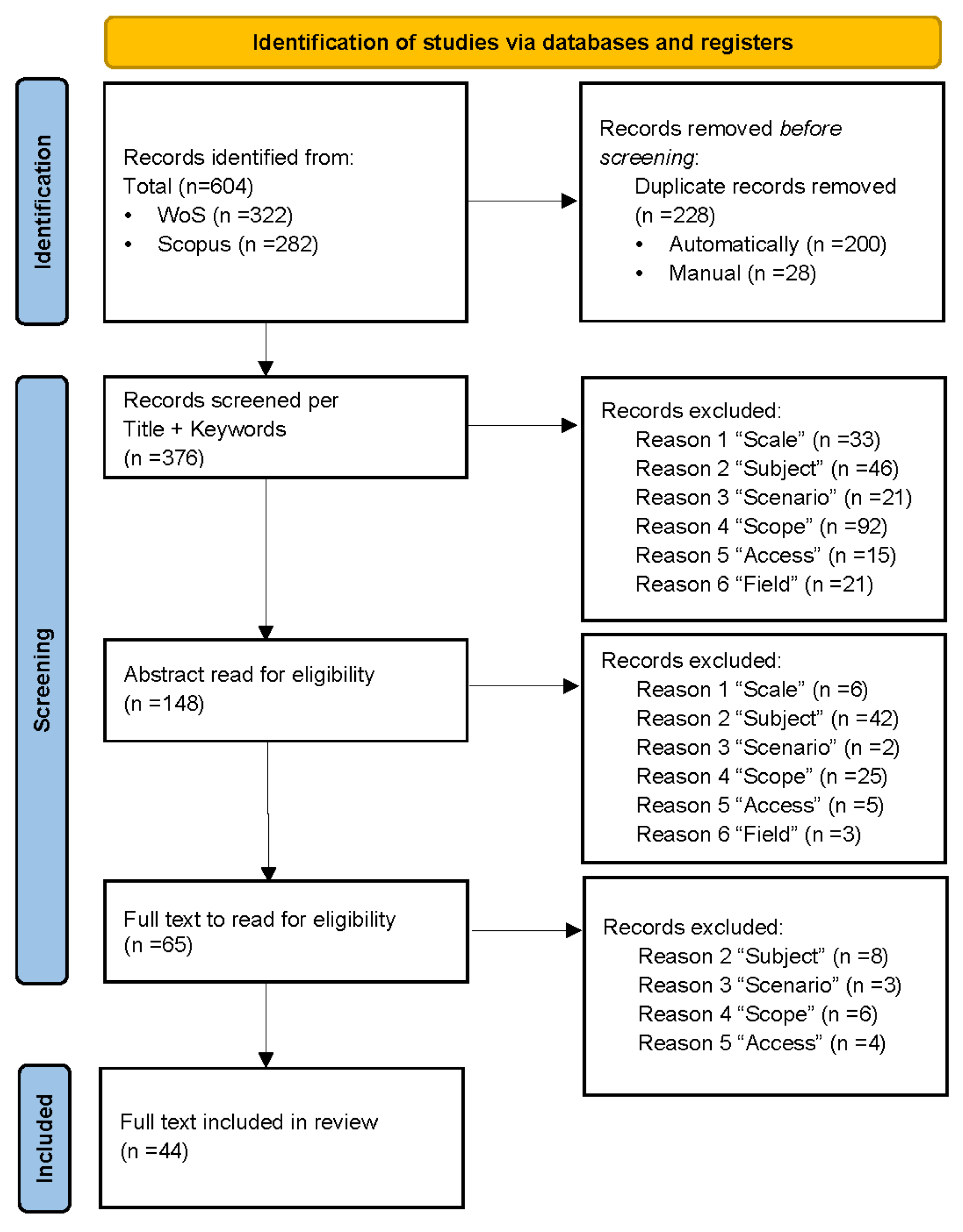

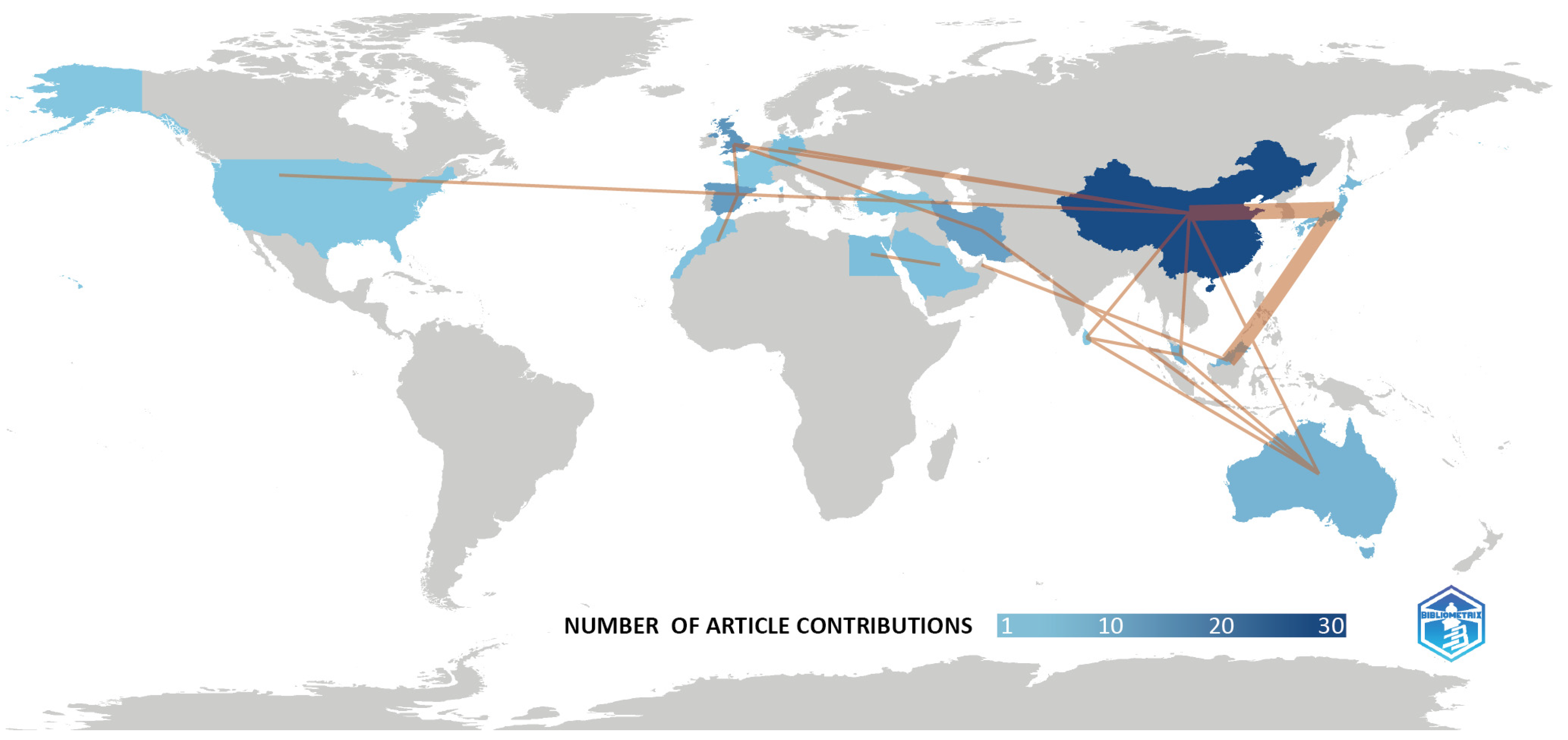
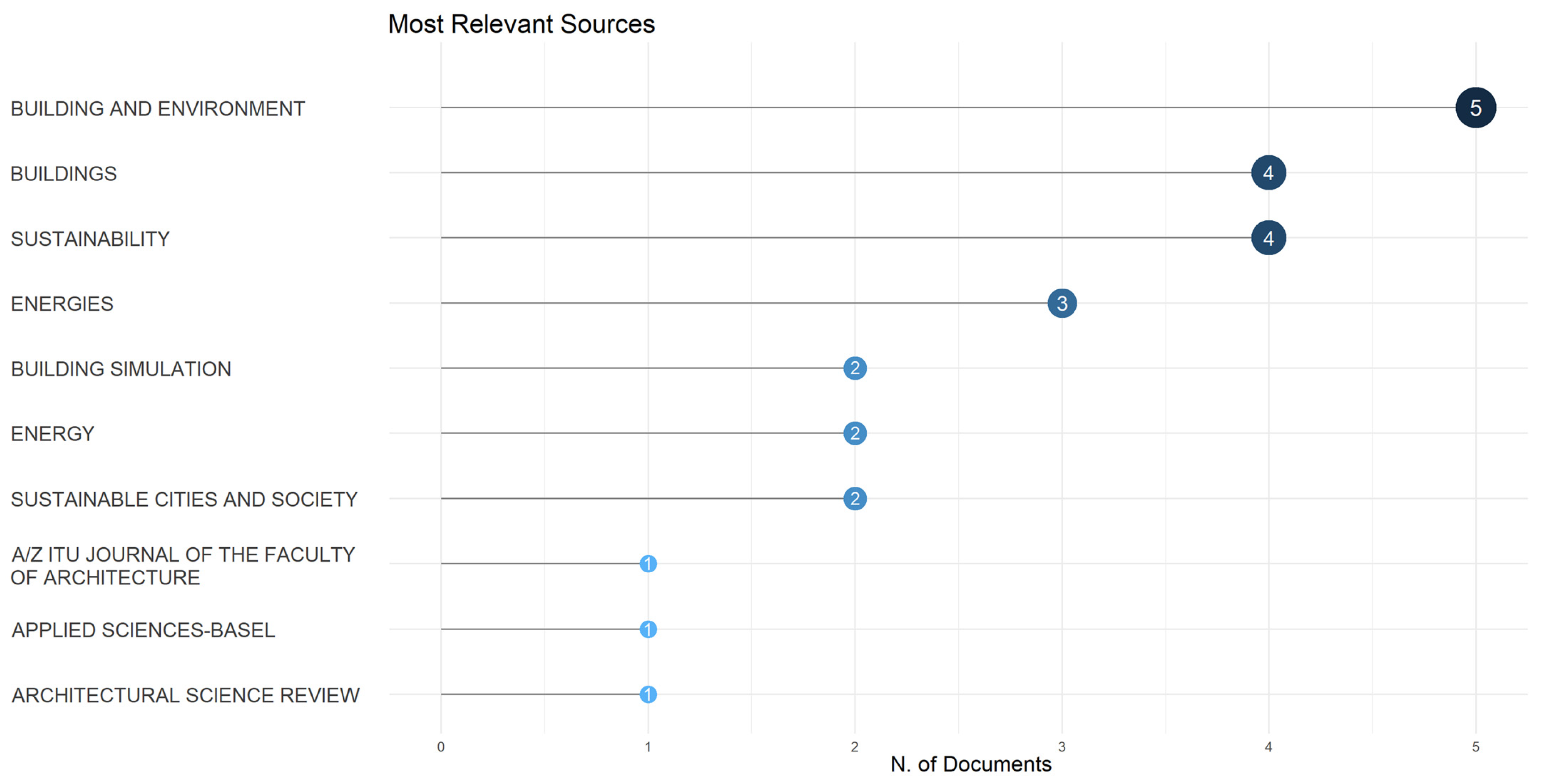
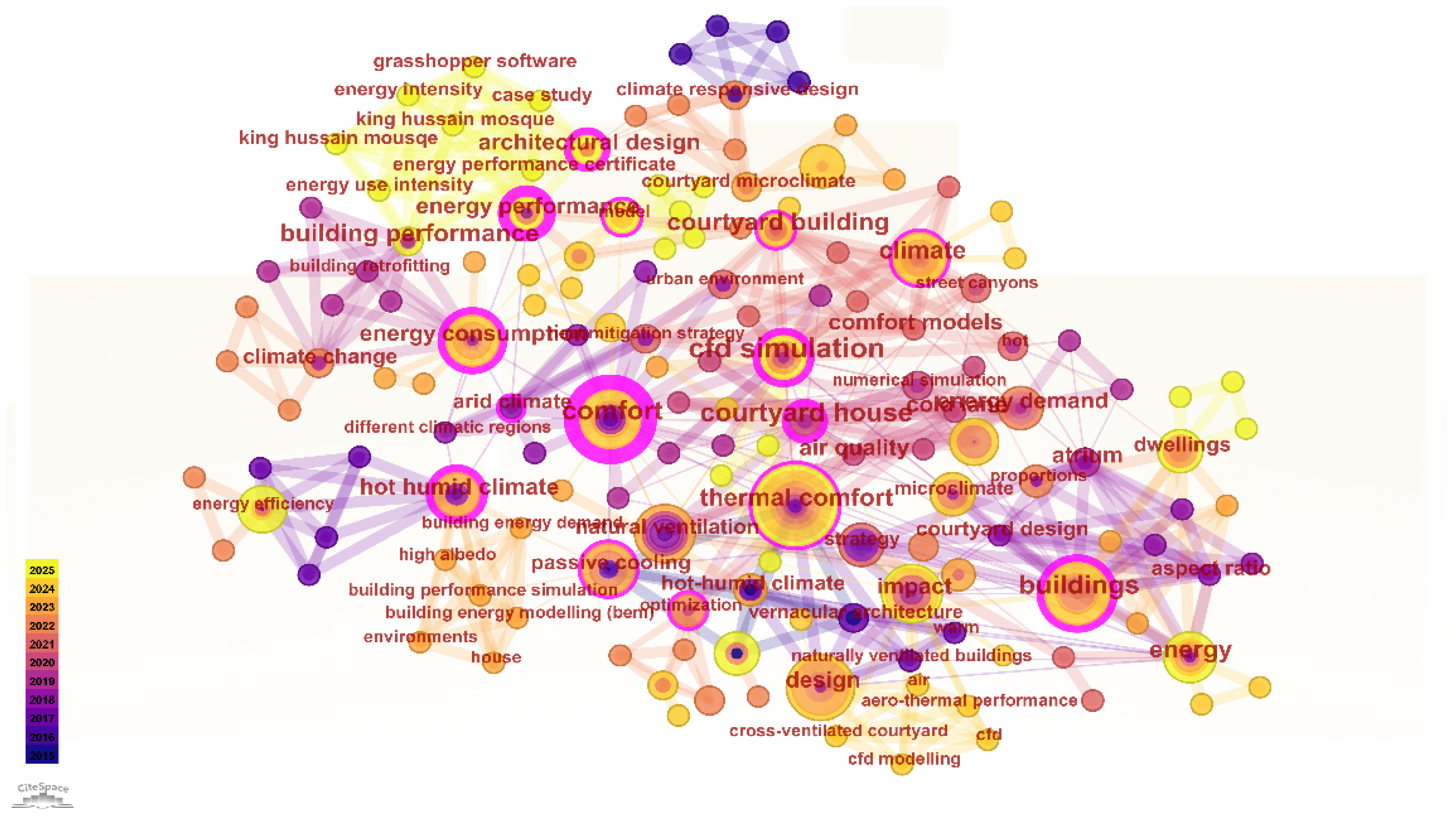
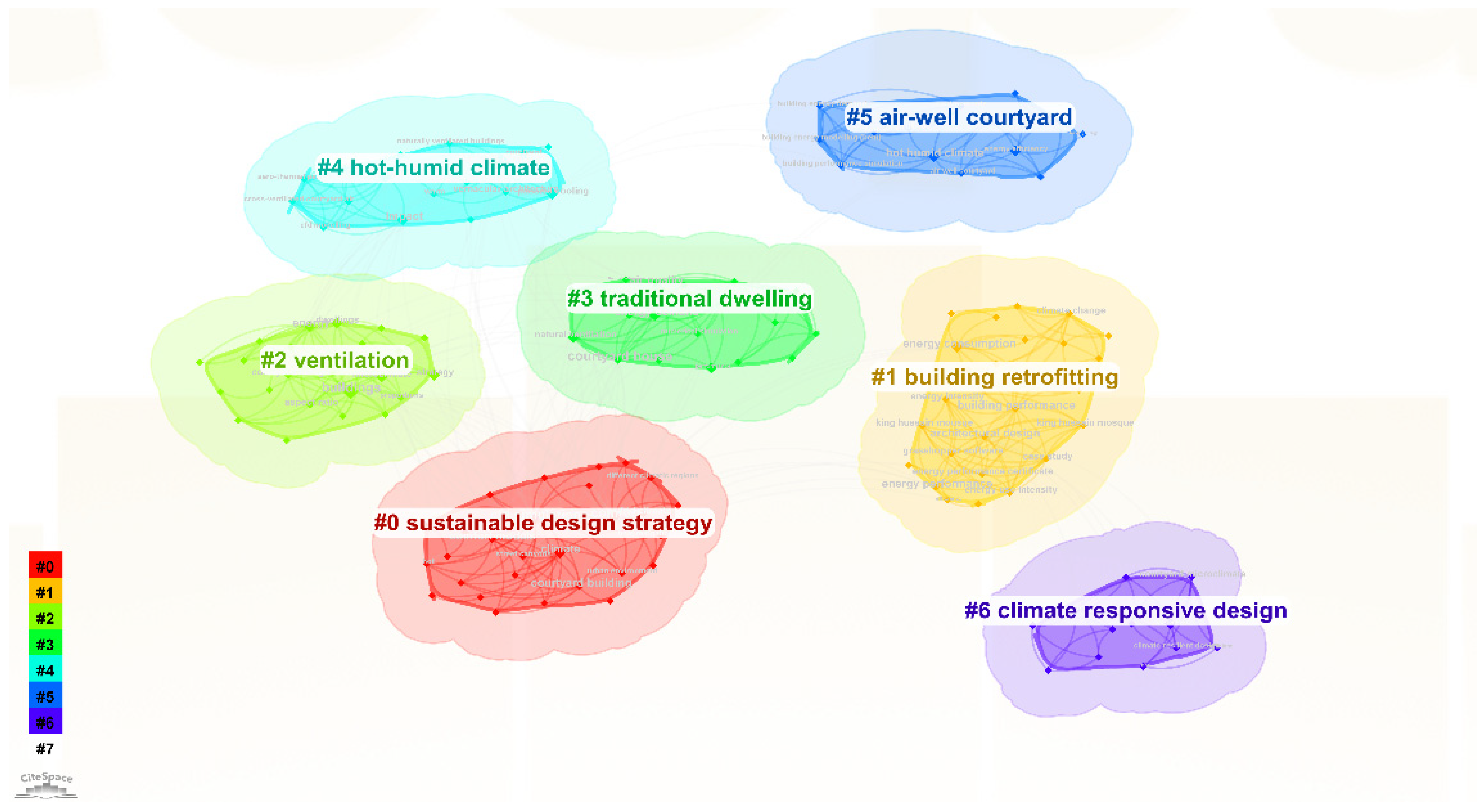
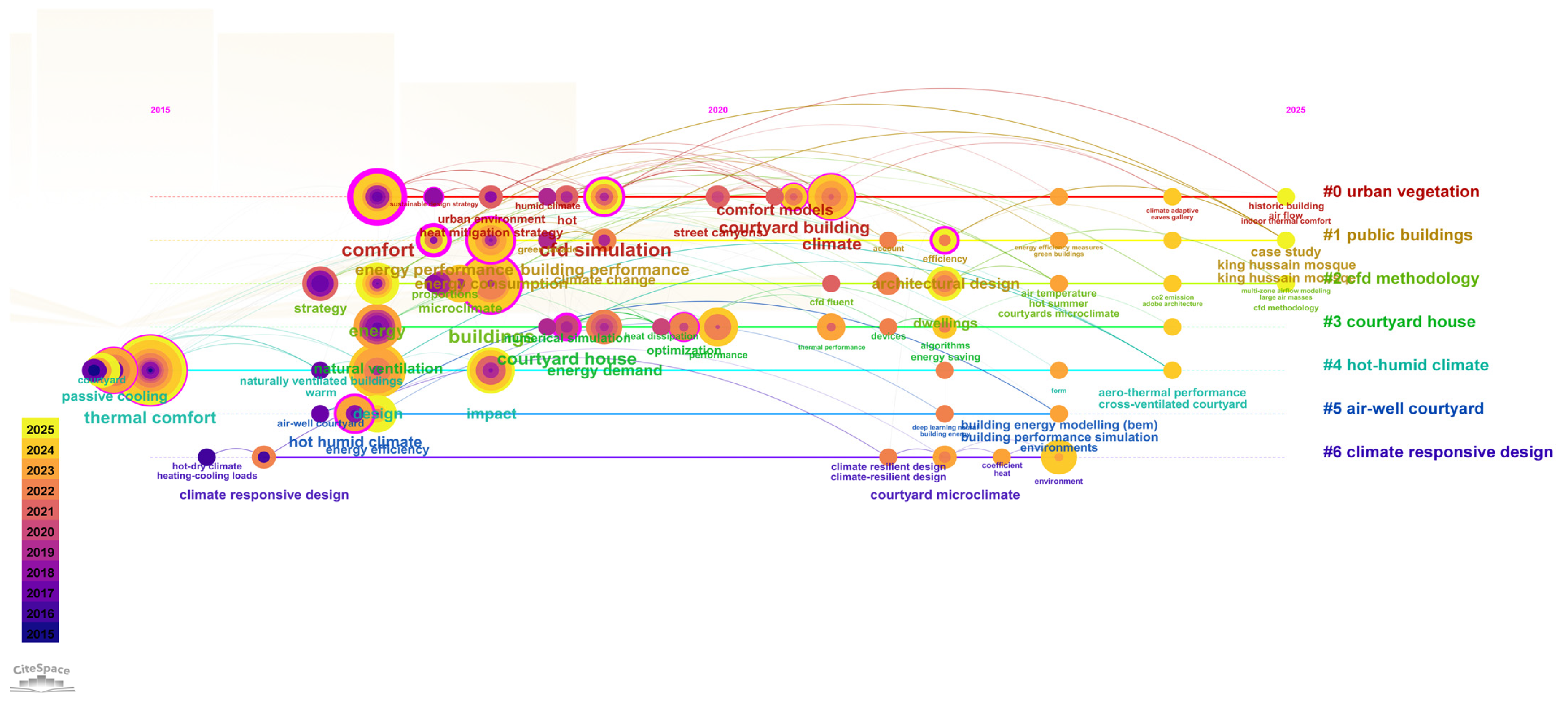
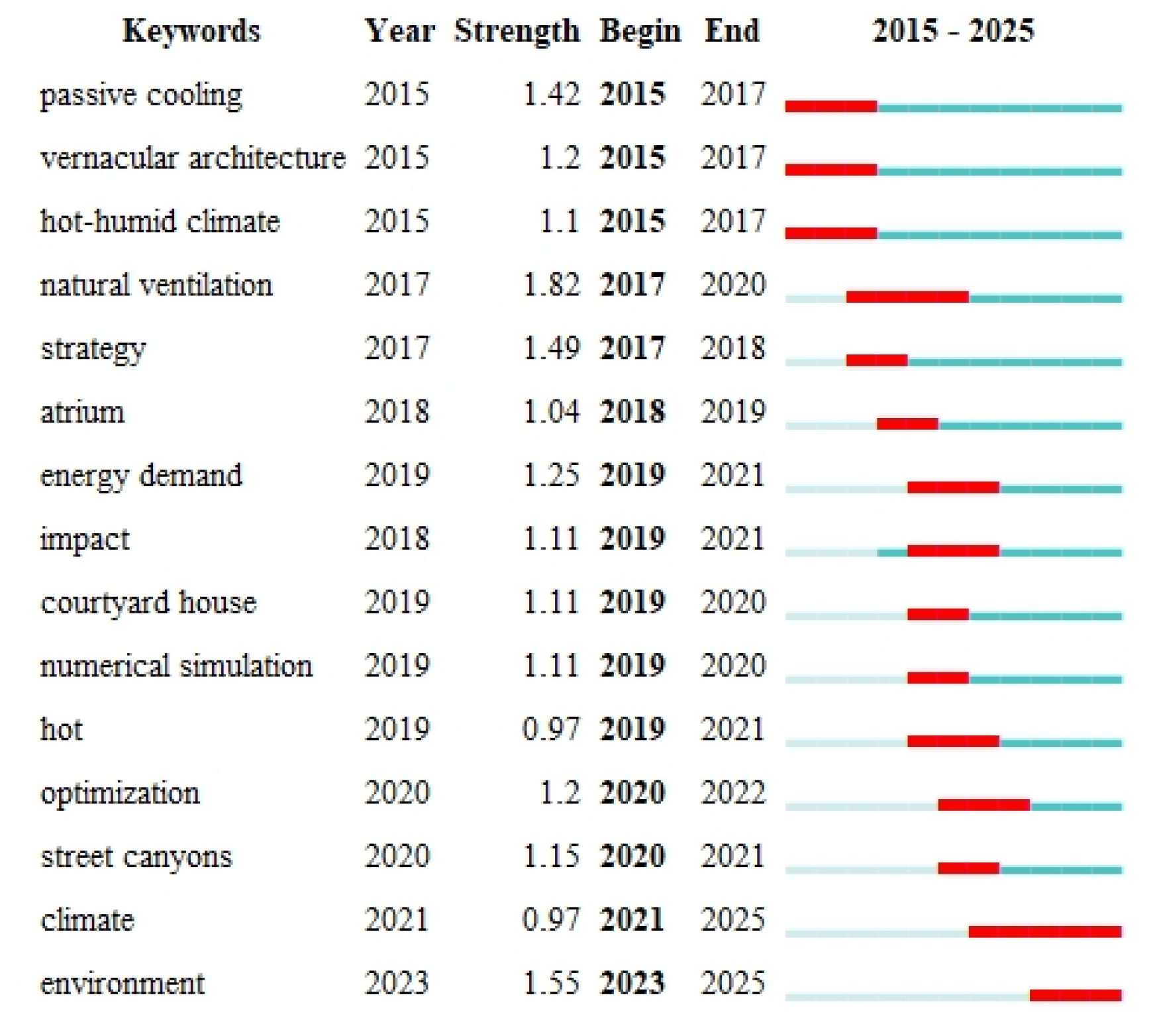
| Database | Categories |
|---|---|
| Web of Science | Construction Building Technology |
| Engineering Civil | |
| Environmental Sciences | |
| Energy Fuels | |
| Green Sustainable Science Technology | |
| Environmental Studies | |
| Engineering Environmental | |
| Thermodynamics | |
| Architecture | |
| Engineering Multidisciplinary | |
| Urban Studies | |
| Scopus | Engineering |
| Environmental Science | |
| Energy |
| Reason Number | Content | Reason |
|---|---|---|
| R1 | Scale | The scope of the study is too broad or extends beyond the building scale, such as focusing on urban microclimate or community-scale environments. |
| R2 | Subject | The core research focus is not on courtyards or their design parameters, for instance, studies centered on green roofs, sunspaces, atrium, or other microclimate interventions are excluded. |
| R3 | Scenario | The study is not focused on high-temperature contexts, such as examining winter heating, annual energy consumption without clearly distinguishing summer performance, or unrelated seasonal conditions. |
| R4 | Scope | The primary aim is not the impact of courtyards on building thermal performance or energy use, e.g., studies focusing only on outdoor comfort, courtyard aesthetics or social functions, or building acoustics or lighting are not considered. |
| R5 | Access | The keywords, abstract or full text are unavailable. |
| R6 | Field | The content belongs to unrelated fields or disciplines, such as biogas reactors, multi-source heat pumps, or agricultural greenhouses. |
| No. | Freq | Centrality | Keywords |
|---|---|---|---|
| 1 | 8 | 0.7 | comfort |
| 2 | 3 | 0.43 | energy performance |
| 3 | 2 | 0.27 | architectural design |
| 4 | 12 | 0.25 | buildings |
| 5 | 7 | 0.25 | energy consumption |
| 6 | 4 | 0.22 | cfd simulation |
| 7 | 4 | 0.21 | hot humid climate |
| 8 | 2 | 0.2 | courtyard house |
| 9 | 3 | 0.18 | courtyard building |
| 10 | 16 | 0.15 | thermal comfort |
| 11 | 7 | 0.13 | passive cooling |
| 12 | 1 | 0.13 | arid climate |
| 13 | 3 | 0.13 | model |
| 14 | 3 | 0.12 | optimization |
| 15 | 7 | 0.11 | climate |
| 16 | 7 | 0.1 | energy |
| 17 | 2 | 0.09 | climate responsive design |
| 18 | 1 | 0.09 | different climatic regions |
| 19 | 2 | 0.08 | climate change |
| 20 | 4 | 0.08 | dwellings |
Disclaimer/Publisher’s Note: The statements, opinions and data contained in all publications are solely those of the individual author(s) and contributor(s) and not of MDPI and/or the editor(s). MDPI and/or the editor(s) disclaim responsibility for any injury to people or property resulting from any ideas, methods, instructions or products referred to in the content. |
© 2025 by the authors. Licensee MDPI, Basel, Switzerland. This article is an open access article distributed under the terms and conditions of the Creative Commons Attribution (CC BY) license (https://creativecommons.org/licenses/by/4.0/).
Share and Cite
Zhou, X.; Antonini, E.; Gaspari, J. Impact of Courtyard Microclimate on Building Thermal Performance Under Hot Weather Conditions: A Review. Energies 2025, 18, 5433. https://doi.org/10.3390/en18205433
Zhou X, Antonini E, Gaspari J. Impact of Courtyard Microclimate on Building Thermal Performance Under Hot Weather Conditions: A Review. Energies. 2025; 18(20):5433. https://doi.org/10.3390/en18205433
Chicago/Turabian StyleZhou, Xu, Ernesto Antonini, and Jacopo Gaspari. 2025. "Impact of Courtyard Microclimate on Building Thermal Performance Under Hot Weather Conditions: A Review" Energies 18, no. 20: 5433. https://doi.org/10.3390/en18205433
APA StyleZhou, X., Antonini, E., & Gaspari, J. (2025). Impact of Courtyard Microclimate on Building Thermal Performance Under Hot Weather Conditions: A Review. Energies, 18(20), 5433. https://doi.org/10.3390/en18205433









